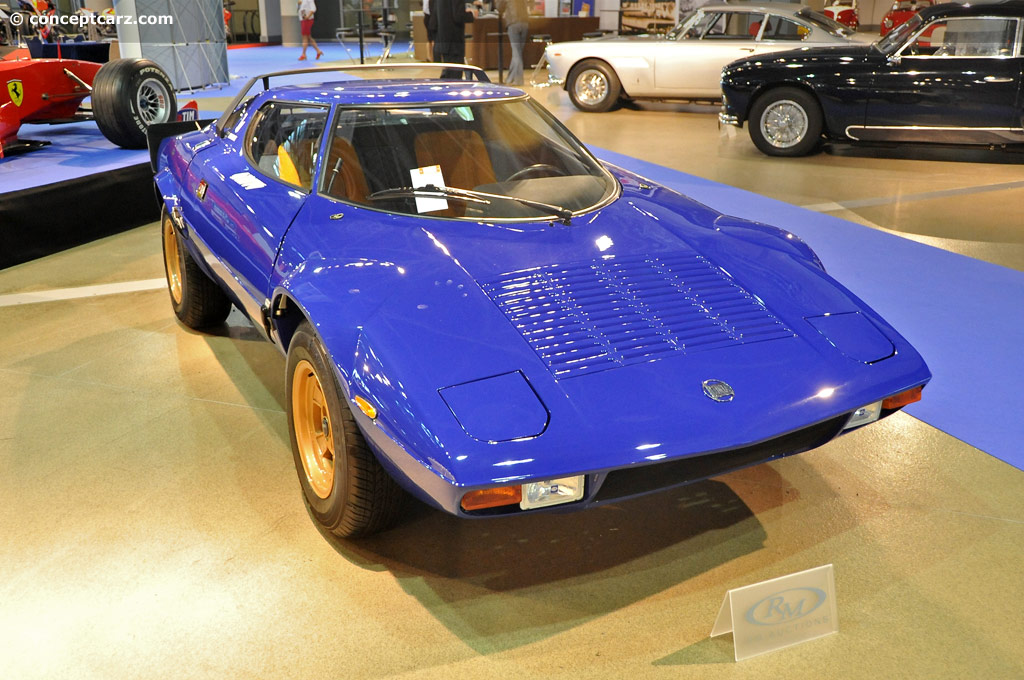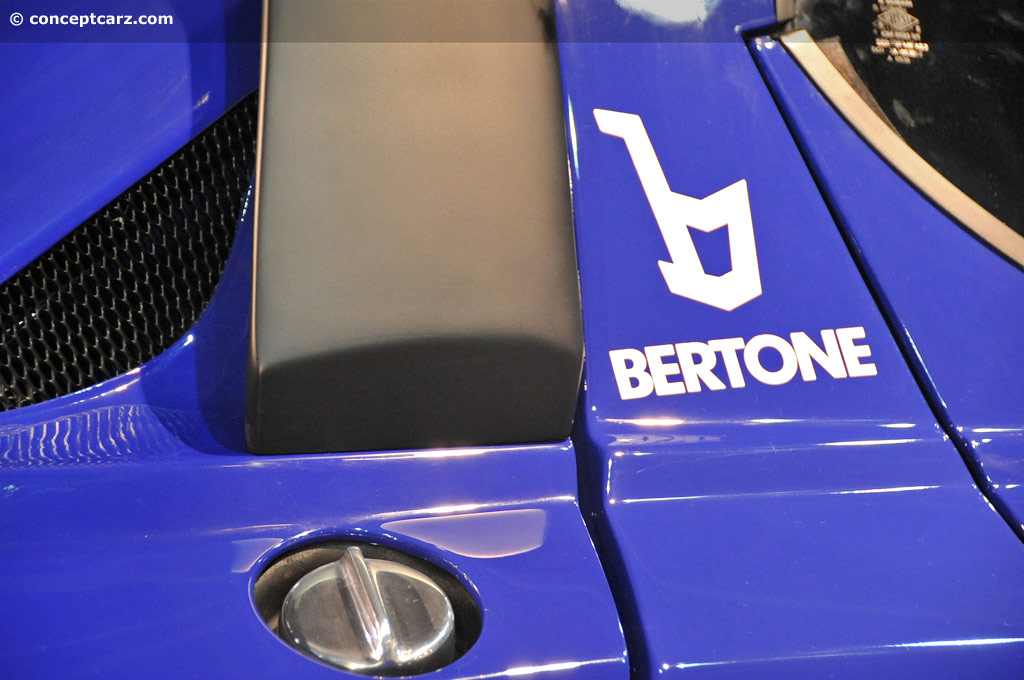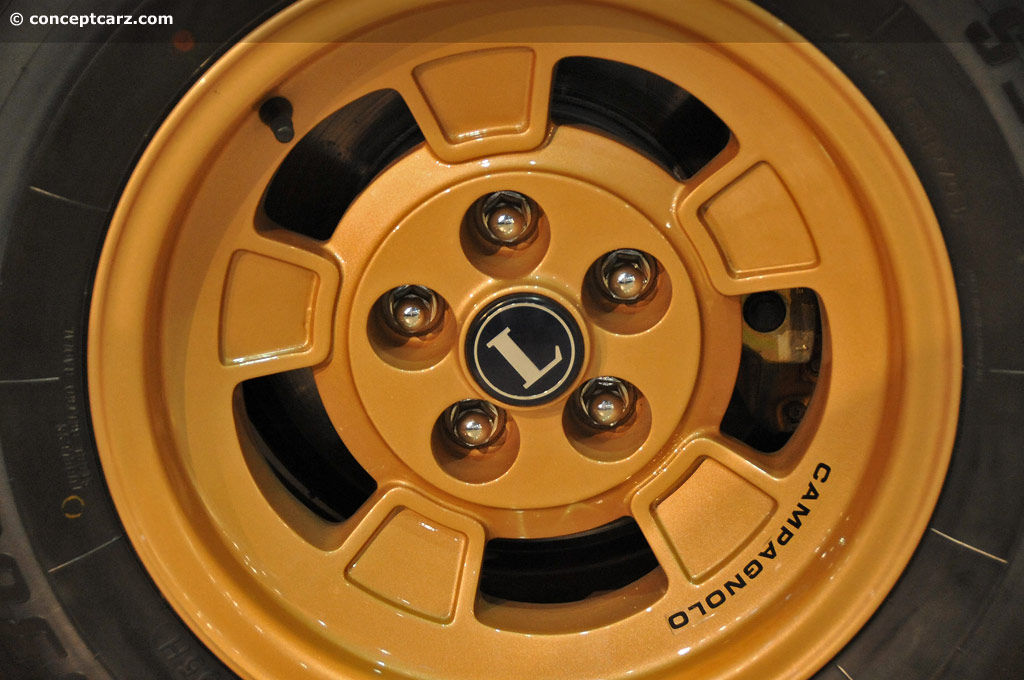The ultimate rally icon of the Group 4 era is arguably the purpose-built Lancia Stratos HF. During its racing career, it won the Tour de France Automobiles five times, the World Rally Championship in 1974, 1975, and 1976, three editions of the Giro d'Italia automobilistico, and the Targa Florio in 1974. 
Stradale Coupe
Chassis #: 829 AR0 001 611
View info and history
Auction entries : 1The development of the Stratos was a body maneuver by Lancia on several fronts. Instead of building the 1,000 units needed to qualify for Group 3 competition, and only afterward applying the allowable Group 4 modifications, Lancia set its sights specifically on Group 4 homologation by building 500 examples as a thinly disguised rally car for the street. Although Pininfarina had traditionally been Lancia's preferred design house, Bertone was selected for the project and represented the first time they worked with Lancia. Bertone himself arrived at the Lancia factory gates with the Stratos Zero Concept, which had been presented in 1970 at the Turin Auto Show. Rather than being stopped at the gate, Bertone himself drove the Stratos Zero underneath the barrier while being applauded by Lancia workers. The Stratos Zero Concept
Marcello Gandini of Bertone perfected the wedge-shaped design concept with the Lamborghini Marzal concept of 1967, the Alfa Romeo Carabo Concept of 1968, and the Stratos Zero. Mounted midship was mechanical components from the Lancia parts bin, including the 1.6-liter Lancia V-4 engine of the Fulvia HF. The sub-chassis and suspension were from a Fulvia Coupe, and the double-wishbones with transverse leaf spring arrangement at the rear were from the Fulvia's front axle. The overall, flowing shape tapered sharply at both ends and was just 84 cm (33 inches) tall. The bodywork was made of fiberglass and gave a copper color scheme. The two-passenger interior seating was positioned as horizontally and as close to the ground as possible. Additional unique features included a digital control screen, a flip-open front-windshield doors, integrated bucket seats, and a retractable steering wheel.Lancia Stratos
The Lancia Stratos was a collaboration between Lancia and Bertone, with the design created by Marcello Gandini. The prototype (chassis 1240) displayed at the Turin Motor Show in November 1971 wore a fluorescent red exterior and had a unique crescent-shaped wrap-around windshield. During the development and testing period, the prototype was fitted with three different engines that included the Lancia Beta engine, a Fulvia engine, and a Ferrari Dino V6.
Stradale Coupe
Chassis #: 829 AR0 001 611
View info and history
Auction entries : 1With 'wedge' shape styling and a stubby overall appearance, it was a dramatic deviation from traditional rally cars design. Its journey to production was helped along by Cesare Fiorio, co-founder of the HF Corse team that had become Lancia's official competitions department in 1965. He was an admirer of Ferrari's quad-cam V6 motor and recognized the aerodynamic efficiencies of the wedge shape and the performance benefits of the mid-engine placement. Nicola Materazzi was a calculations engineer who was tasked by Lancia to thoroughly evaluate many of the mechanical components, including the chassis, suspension, steering, and engine. Additionally, British engineer Mike Parkes and factory rally driver Sandro Munari gave input on the bodywork, design, and mechanical configuration. Production commenced in earnest as Group 4 Homologation requirements required that 500 examples be built within a 24-month period. However, requirements did not specify that 500 cars needed to be completed, but rather enough chassis and components were needed to complete that number. Production began on July 1st, 1972, and by the close of 1974, just 183 examples had been completed. Group 4 homologation was granted on October 1st, 1974, after FIA determined that enough components and completed body shells existed. The body production and final assembly continued into 1975, with approximately 492 examples eventually completed. The production road-going versions were known as 'Stradale' and it is believed that 250 road-going versions were built. 
Stradale Coupe
Chassis #: 829 AR0 001 611
View info and history
Auction entries : 1The Stratos HF, with the 'HF' representing 'High Fidelity,' was sold as the Lancia Stratos HF Stradale. The Stradale was slightly detuned (compared to the competition cars) for reliability, one of the few concessions to civility. Much of the mechanical components remained the same as the competition version, including the gearbox, independent suspension, ventilated brakes, rear-wheel drive, and even the helmet holders beneath the side windows.Mechanical Specification
The Lancia Stratos wore body shells built by Bertone at its Grugliasco Works, and then shipped to Lancia for final assembly at Via San Paolo. Beneath the body was a central steel monocoque, with steel front frame legs and a box-section rear subframe. There were hinged 'clamshells' at the front and rear and lightweight fiberglass doors.The Stratos had an 85.8 inch (2180mm) wheelbase, an overall length of 146.1 inches (3710mm), a 68.9 inch (1750mm) width, and stood 43.7 inches (1110mm) tall.
Stradale Coupe
Chassis #: 829 AR0 001 611
View info and history
Auction entries : 1Mounted mid-ship was a transverse 2.4-liter Ferrari Dino V-6 engine that Enzo Ferrari only reluctantly agreed to supply. The 2,418cc DOHC 65-degree V6 breathed through triple Weber 40 IDF carburetors, produced 190 horsepower (in Stradale configuration) at 7,000 RPM and 166 lb-ft of torque at 4,000 RPM, and was paired with a five-speed manual transmission. The works Group 4 rally cars were considerably more powerful but at the expense of reliability. The twelve-valve version delivered around 275 horsepower and the 24-valve version around 320 horsepower. The 24-valve version was banned from Group 4 competition for the 1978 season by an FIA rule change. Disc brakes were positioned behind each wheel. Designed to cope with all types of rallying, the Stratos received a fully adjustable, all-independent suspension by double wishbones and coil springs.Testing
During the 1972 and 1973 seasons, the Stratos raced in several Group 5 prototype events. The Group 5 Sports Car category regulations for 1972 excluded a minimum production requirement and limited engine capacity to 3 liters (requirements previously known as the Group 6 Prototype Sports Cars category).The Stratos HF made its competition debut in November 1972 on the Tour de Corse, running as a prototype. Its first successes would come the following year, with wins on the Tour de France and the Firestone Rally, and a 2nd place at the Targa Florio. Competition
Despite proper development and testing and input from some of the most knowledgeable racers and engineers at Lancia's disposal, the Stratos HF struggled with reliability, often sidelined due to transmission issues.
Stradale Coupe
Chassis #: 829 AR0 001 611
View info and history
Auction entries : 1On October 1, 1974, the Lancia Stratos was homologated for the 1974 Group 4 World Rally Championship and, over the next five years, would record over 80 international victories. It secured three WRC Manufacturers' Championships from 1974 to 1976 with drivers Sandro Munari and Björn Waldegård, and after its factory campaign was over, the Stratos continued to be successful in the hands of privateers, helping Sandro Munari to the WRC Drivers' Championship in 1977 and even winning the Monte Carlo Rally in 1979 (it also won the Monte Carlo Rally in 1975, 1976 and 1977).Three victories were earned during the 1974 WRC season, two by Sandro Munari and co-driver Mario Mannucci and one by Jean-Claude Andruet with co-driver Michèle Petit. During the 1975 WRC season, Munari and Mannucci scored one victory, Björn Waldegård and Hans Thorszelius placed first on two occasions, and Bernard Darniche and Alain Mahé had a sole victory. Munari and Silvio Maiga had three victories in the 1976 WRC competition and one in 1977. Waldegård and Thorszelius also had a victory in 1976. Victories during the 1978 season were earned by Ilkka Kivimaki and co-driver Ilkka Kivimaki and by Tony Carello. Internal politics within the Fiat Group placed the mantle of responsibility with rally competition on the Fiat 131 Abarths. Even with the withdrawal of factory support and new regulations which limited engine output, the Lancia Stratos HF continued to remain competitive, evening besting works cars on several occasions. The final victory for the Stratos was at the 1981 Tour de Corse Automobile - a World Rally Championship event - where it was piloted by Bernard Darniche and co-driver Alain Mahe (a duo who also scored two victories in 1979).
Stradale Coupe
Chassis #: 829 AR0 001 611
View info and history
Auction entries : 1The success of the Stratos in rally racing is attributed to its agility, diminutive size, and potent six-cylinder engine.
by Daniel Vaughan | Jan 2023

Stradale Coupe
Chassis #: 829 AR0 001 611
View info and history
Auction entries : 1
Marcello Gandini of Bertone perfected the wedge-shaped design concept with the Lamborghini Marzal concept of 1967, the Alfa Romeo Carabo Concept of 1968, and the Stratos Zero. Mounted midship was mechanical components from the Lancia parts bin, including the 1.6-liter Lancia V-4 engine of the Fulvia HF. The sub-chassis and suspension were from a Fulvia Coupe, and the double-wishbones with transverse leaf spring arrangement at the rear were from the Fulvia's front axle. The overall, flowing shape tapered sharply at both ends and was just 84 cm (33 inches) tall. The bodywork was made of fiberglass and gave a copper color scheme. The two-passenger interior seating was positioned as horizontally and as close to the ground as possible. Additional unique features included a digital control screen, a flip-open front-windshield doors, integrated bucket seats, and a retractable steering wheel.Lancia Stratos
The Lancia Stratos was a collaboration between Lancia and Bertone, with the design created by Marcello Gandini. The prototype (chassis 1240) displayed at the Turin Motor Show in November 1971 wore a fluorescent red exterior and had a unique crescent-shaped wrap-around windshield. During the development and testing period, the prototype was fitted with three different engines that included the Lancia Beta engine, a Fulvia engine, and a Ferrari Dino V6.

Stradale Coupe
Chassis #: 829 AR0 001 611
View info and history
Auction entries : 1

Stradale Coupe
Chassis #: 829 AR0 001 611
View info and history
Auction entries : 1
The Lancia Stratos wore body shells built by Bertone at its Grugliasco Works, and then shipped to Lancia for final assembly at Via San Paolo. Beneath the body was a central steel monocoque, with steel front frame legs and a box-section rear subframe. There were hinged 'clamshells' at the front and rear and lightweight fiberglass doors.The Stratos had an 85.8 inch (2180mm) wheelbase, an overall length of 146.1 inches (3710mm), a 68.9 inch (1750mm) width, and stood 43.7 inches (1110mm) tall.

Stradale Coupe
Chassis #: 829 AR0 001 611
View info and history
Auction entries : 1
During the 1972 and 1973 seasons, the Stratos raced in several Group 5 prototype events. The Group 5 Sports Car category regulations for 1972 excluded a minimum production requirement and limited engine capacity to 3 liters (requirements previously known as the Group 6 Prototype Sports Cars category).The Stratos HF made its competition debut in November 1972 on the Tour de Corse, running as a prototype. Its first successes would come the following year, with wins on the Tour de France and the Firestone Rally, and a 2nd place at the Targa Florio. Competition
Despite proper development and testing and input from some of the most knowledgeable racers and engineers at Lancia's disposal, the Stratos HF struggled with reliability, often sidelined due to transmission issues.

Stradale Coupe
Chassis #: 829 AR0 001 611
View info and history
Auction entries : 1

Stradale Coupe
Chassis #: 829 AR0 001 611
View info and history
Auction entries : 1
by Daniel Vaughan | Jan 2023
Related Reading : Lancia Stratos History
A big success by any standard both in and out of competition, the Lancia Stratos was developed as a homologation Special for European rallying. After production ceased, it became a cult car and is now highly-priced as the modern classis it is. Conceived strictly for rallying, the Lancia Stratos, however, makes an exciting road car, though it is very far from GT standards in both luxury and refinement. The....
Continue Reading >>
Continue Reading >>
Similarly Sized Vehicles
from 1976
1976 Lancia HF Stratos Vehicle Profiles
Recent Vehicle Additions
Performance and Specification Comparison
Stratos HF Stradale Specification Comparison by Year
Year
Production
Wheelbase
Engine
Prices
Related Automotive News

Lamborghini Celebrates The 50Th Anniversary Of The Jarama GT
This year marks the 50th Anniversary of the Lamborghini Jarama GT, presented for the first time at the Geneva Motor Show in March 1970.
The Jarama, whose name derives from an area north of Madrid famous for breeding fighting bulls, was the latest evolution...

Gripped By Quattro – Celebrating Forty Years Of The Audi All-Wheel Drive Road And Rally Icon
Forty years of quattro
Harald Demuth – Developing the new secret Audi rally weapon
David Ingram – Hoisting the quattro high above the capital
Phil Short – Winning in a rally quattro first time out
Graham Rood – Plotting the route to victor...

Alpine Passion Through The Years At Retromobile
Retromobile set to play host to six classic Alpine models
The Alpine Vision show car will also be on display as a symbolic bridge between the brands past and future
Groupe Renault is pleased to confirm Alpines participation in the 42nd Retromobi...

THE FULL 'MONTE': THE NEW POLO R WRC MAKES ITS DEBUT AT A RALLY CLASSIC
First big test for the second generation Polo R WRC
Volkswagen drivers Ogier, Latvala and Mikkelsen first onto the Monte route
Home race for world champion Ogier – Gap (F) hosts WRC opener
Tough test for the new, second generation of the Polo R...

Fiat Chrysler Automobiles key player in the Classic Days in Germany
Concours delegance, parades and special races on roads closed to traffic this is the packed programme reserved for the historic cars arriving at the medieval Dyck castle
Alfa Romeo takes part with four precious models the prototype 750 Competizi...
























